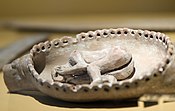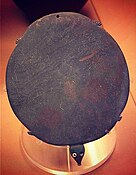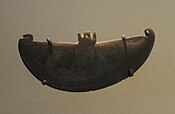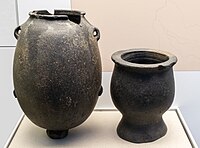Amratian culture


The Amratian culture, also called Naqada I, was an archaeological culture of prehistoric Upper Egypt. It lasted approximately from 4000 to 3500 BC.[2]
Overview
The Amratian culture is named after the archaeological site of el-Amrah, located around 120 km (75 mi) south of Badari in Upper Egypt. El-Amrah was the first site where this culture group was found without being mingled with the later Gerzeh culture (Naqada II). However, this period is better attested at the Nagada site, thus it also is referred to as the Naqada I culture.[3] Black-topped pottery continued to be produced, but white cross-line pottery, a type which has been decorated with close parallel white lines being crossed by another set of close parallel white lines, begins to be produced during this time. The Amratian falls between S.D. 30 and 39 in Flinders Petrie's sequence dating system.[4][5]
Trade between the Amratian culture bearers in Upper Egypt and populations of Lower Egypt is attested during this time through new excavated objects. A stone vase from the north has been found at el-Amrah. The predecessor Badarian culture had also discovered that malachite could be heated into copper beads;[a] the Amratians shaped this metal by chipping.[6] Obsidian and a very small amount of gold were both imported from Nubia during this time.[3][4] Trade with the oases also was likely.[3] Cedar was imported from Byblos, marble from Paros, as well as emery from Naxos.[6]
New innovations such as adobe buildings, for which the Gerzeh culture is well known, also begin to appear during this time, attesting to cultural continuity. However, they did not reach nearly the widespread use that they were known for in later times.[7] Additionally, oval and theriomorphic cosmetic palettes appear to be used in this period. However, the workmanship was still very rudimentary and the relief artwork for which they were later known is not yet present.[8]
Each Amratian village had an animal deity; amulets were worn of humans and various animals including birds and fish. Food, weaponry, statuettes, decorations, malachite, and occasionally dogs were buried with the deceased.[6]
-
 Ovoid Naqada I (Amratian) black-topped terracotta vase, c. 3800–3500 BC
Ovoid Naqada I (Amratian) black-topped terracotta vase, c. 3800–3500 BC - Clay model of four head of cattle, c. 3500 BC, found at El-Amrah
-
 Clay figure, Egypt Naqada I period, circa 4000 BC. RMO Leiden
Clay figure, Egypt Naqada I period, circa 4000 BC. RMO Leiden -
![Egyptian disk-shaped macehead, 4000–3400 BCE. At the end of the period, it was replaced by the superior Mesopotamian-style pear-shaped macehead, as seen on the Narmer Palette.[9]](//upload.wikimedia.org/wikipedia/commons/thumb/9/93/Egyptian_disk_macehead_4000-3400_BCE.jpg/175px-Egyptian_disk_macehead_4000-3400_BCE.jpg) Egyptian disk-shaped macehead, 4000–3400 BCE. At the end of the period, it was replaced by the superior Mesopotamian-style pear-shaped macehead, as seen on the Narmer Palette.[9]
Egyptian disk-shaped macehead, 4000–3400 BCE. At the end of the period, it was replaced by the superior Mesopotamian-style pear-shaped macehead, as seen on the Narmer Palette.[9]
Early cosmetic palettes
Siltstone was first utilized for cosmetic palettes by the Badari culture. The first palettes used in the Badarian Period and in Naqada I were usually plain, rhomboidal or rectangular in shape, without any further decoration. It is in the Naqada II period in which the zoomorphic palette is most common.
-
 Mudstone cosmetic palette in the form of a turtle with inlaid bone eyes (one missing). Predynastic, Naqada I. 4000–3600 BC. EA 37913 (British Museum)
Mudstone cosmetic palette in the form of a turtle with inlaid bone eyes (one missing). Predynastic, Naqada I. 4000–3600 BC. EA 37913 (British Museum) -
 Mudstone palette in the form of a hippopotamus. Predynastic, Naqada I. 4000–3600 BC. EA 29416. (British Museum)
Mudstone palette in the form of a hippopotamus. Predynastic, Naqada I. 4000–3600 BC. EA 29416. (British Museum) -
 Naqada I–II palette for blending cosmetics
Naqada I–II palette for blending cosmetics -
 Palette in the shape of a boat, 3700–3600 BC, Naqada I
Palette in the shape of a boat, 3700–3600 BC, Naqada I
Bearded figurines
Many figurines are known from Naqada I, which were carved on animal tusks. The figurines usually have pointed beards, and some trace of hair.[10] They may represent people dressed in long cloaks.[10] Bearded men also appear in many other pre-dynastic artifacts, such as the Gebel el-Arak Knife.[11] The headgear of the Mesopotamian-style "Lord of Animals" on the Gebel el-Arak knife may also be comparable to the torus-shaped headgear visible on many of the Naqada I figurines.[11]
-
 Figurine of a bearded man by the Naqada I culture, 3800–3500 BC, from Upper Egypt. Musée des Confluences (Lyon, France)
Figurine of a bearded man by the Naqada I culture, 3800–3500 BC, from Upper Egypt. Musée des Confluences (Lyon, France) -
![Hippopotamus tusk with carved head of a bearded man with torus-like headgear, Late Naqada I – Early Naqada II, 3800–3400 BC. Brooklyn Museum.[11]](//upload.wikimedia.org/wikipedia/commons/thumb/8/83/Hippopotamus_Tusk_with_Carved_Head_Naqada_I-II_%28detail%29.jpg/144px-Hippopotamus_Tusk_with_Carved_Head_Naqada_I-II_%28detail%29.jpg) Hippopotamus tusk with carved head of a bearded man with torus-like headgear, Late Naqada I – Early Naqada II, 3800–3400 BC. Brooklyn Museum.[11]
Hippopotamus tusk with carved head of a bearded man with torus-like headgear, Late Naqada I – Early Naqada II, 3800–3400 BC. Brooklyn Museum.[11] -
 Hippopotamus tusk with carved head, 3800–3400 BCE, Naqada I–II
Hippopotamus tusk with carved head, 3800–3400 BCE, Naqada I–II -
 Figurine, Ägyptisches Museum Berlin
Figurine, Ägyptisches Museum Berlin
Other artifacts
-
 Lower-Egypt basalt jars in the shape of pottery from Maadi, Naqada I–II, British Museum EA 34398, EA 26654
Lower-Egypt basalt jars in the shape of pottery from Maadi, Naqada I–II, British Museum EA 34398, EA 26654
Relative chronology
- v
- t
- e
See also

References
Footnotes
- ^ Copper may have also been imported from the Sinai Peninsula or perhaps Nubia.
Citations
- ^ Hendrickx, Stan. "The relative chronology of the Naqada culture: Problems and possibilities [in:] Spencer, A.J. (ed.), Aspects of Early Egypt. London: British Museum Press, 1996: 36-69": 64.
{{cite journal}}: Cite journal requires|journal=(help) - ^ Shaw, Ian, ed. (2000). The Oxford History of Ancient Egypt. Oxford University Press. p. 479. ISBN 0-19-815034-2.
- ^ a b c Grimal, Nicolas (1992). A History of Ancient Egypt. Blackwell. p. 28. ISBN 0-631-17472-9.
- ^ a b Gardiner, Alan (1964). Egypt of the Pharaohs. Oxford: University Press. p. 390.
- ^ Newell, G.D. (2012). The relative chronology of PNC I. A new chronological synthesis for the Egyptian Predynastic. ex.cathedra Press.
- ^ a b c Smith, Homer W. (2015) [1952]. Man and His Gods. Lulu Press. pp. 16–17. ISBN 9781329584952.[permanent dead link]
- ^ Redford, Donald B. (1992). Egypt, Canaan, and Israel in Ancient Times. Princeton: University Press. p. 7. ISBN 0-691-03606-3.
- ^ Gardiner, Alan (1964). Egypt of the Pharaohs. Oxford: University Press. p. 393.
- ^ Isler, Martin (2001). Sticks, Stones, and Shadows: Building the Egyptian Pyramids. University of Oklahoma Press. p. 42. ISBN 978-0-8061-3342-3.
- ^ a b Hendrickx, Stan; Adams, Barbara; Friedman, R. F. (2004). Egypt at Its Origins: Studies in Memory of Barbara Adams: Proceedings of the International Conference "Origin of the State, Predynastic and Early Dynastic Egypt", Krakow, 28 August – 1 September 2002. Peeters Publishers. p. 892. ISBN 978-90-429-1469-8.
- ^ a b c Hendrickx, Stan; Adams, Barbara; Friedman, R. F. (2004). Egypt at Its Origins: Studies in Memory of Barbara Adams : Proceedings of the International Conference "Origin of the State, Predynastic and Early Dynastic Egypt", Krakow, 28 August – 1st September 2002. Peeters Publishers. p. 894. ISBN 978-90-429-1469-8.



![Egyptian disk-shaped macehead, 4000–3400 BCE. At the end of the period, it was replaced by the superior Mesopotamian-style pear-shaped macehead, as seen on the Narmer Palette.[9]](http://upload.wikimedia.org/wikipedia/commons/thumb/9/93/Egyptian_disk_macehead_4000-3400_BCE.jpg/175px-Egyptian_disk_macehead_4000-3400_BCE.jpg)





![Hippopotamus tusk with carved head of a bearded man with torus-like headgear, Late Naqada I – Early Naqada II, 3800–3400 BC. Brooklyn Museum.[11]](http://upload.wikimedia.org/wikipedia/commons/thumb/8/83/Hippopotamus_Tusk_with_Carved_Head_Naqada_I-II_%28detail%29.jpg/144px-Hippopotamus_Tusk_with_Carved_Head_Naqada_I-II_%28detail%29.jpg)



















